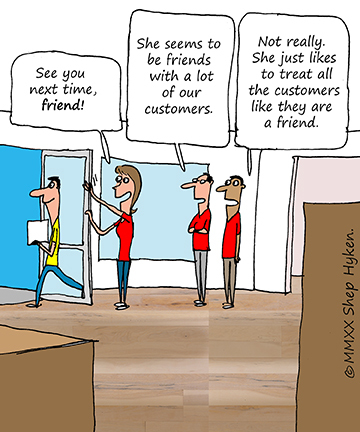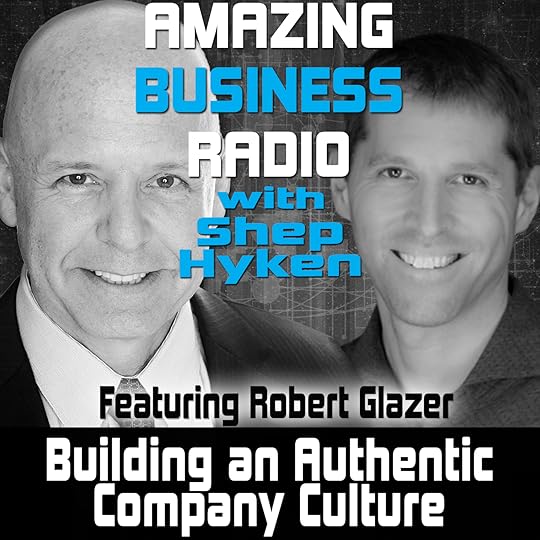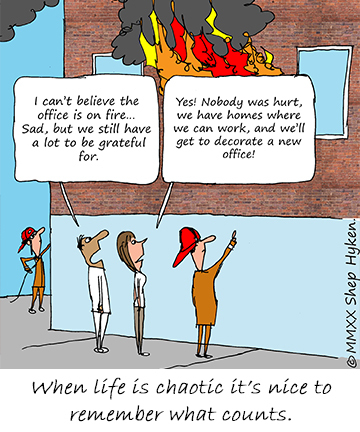Shep Hyken's Blog, page 99
September 9, 2020
When Surprise and Delight Becomes Surprise Without Delight
 We’ve all heard the expression surprise and delight. The intention is that we surprise our customers with better-than-expected service.
We’ve all heard the expression surprise and delight. The intention is that we surprise our customers with better-than-expected service.
The result is that they are delighted. But what happens when the intended surprise does not delight?
That’s exactly what happened to my friend and fellow professional speaker, Beth Terry. She has a three-bedroom home. The third bedroom is used as an office. She hired a cleaning service to clean her home, and specifically told them not to go into the third bedroom. She told the cleaning crew where she wanted them to focus their efforts for the time they were there. She also told them they had to be finished by a certain time. But what did the cleaning crew do? They decided to surprise Beth, thinking they would delight her. They went into the third bedroom and cleaned it anyway. They didn’t intend to charge her. The problem was that they didn’t finish on time and guests showed up while the cleaning crew was still cleaning. So, instead of a surprise and delight experience, Beth got surprise and disappointment.
There are times when surprise and delight works—for example, when the server at a restaurant overhears that it’s a guest’s birthday and surprises them with a dessert with a candle. I can’t think why anyone wouldn’t be delighted and appreciative of this surprise gesture. But what if the guests had told the server when they sat down that they needed to be out by a certain time. Then the surprise comes and makes them late. Nice effort on behalf of the service, but it’s tainted because the server should have known about the time constraint or been more aware.
I have a friend that sent a gift box of chocolates to a client, only to find out later the client was diabetic. Nice effort, and the client may have appreciated the effort, but unfortunately, the client couldn’t appreciate the actual gift.
Back to general customer service. Fellow customer service expert, Matt Dixon, co-author of The Effortless Experience, takes the position that customers don’t really care about the surprise. They just want delight. That delight comes in the form of an easy—as in effortless—experience that ends with the customer being happy with the result. You don’t need to surprise them with a gift or a discount on their next purchase. You just need to give them what they want—the resolution to their problem without any hassle or stress.
While I love the concept of surprising the customer, if you are going to give a surprise, be sure it’s going to be appreciated and appropriate. Never lose sight of what the customer expects. Meeting that expectation may be all you have to do to surprise and delight.
Shep Hyken is a customer service expert, keynote speaker, and New York Times bestselling business author. For information, contact 314-692-2200 or www.hyken.com. For information on The Customer Focus customer service training programs, go to www.thecustomerfocus.com. Follow on Twitter: @Hyken
customer service training programs, go to www.thecustomerfocus.com. Follow on Twitter: @Hyken
(Copyright © MMXX, Shep Hyken)
The post When Surprise and Delight Becomes Surprise Without Delight appeared first on Shep Hyken.
September 8, 2020
Amazing Business Radio: Chip Bell

Getting Inside Your Customer’s Imagination
Creating a Company with the Best Customer Experience Culture
Shep Hyken interviews Chip Bell, customer service keynote speaker and bestselling author. They discuss the 5 Secrets from his new book, Inside Your Customer’s Imagination, that can help organizations better understand their customers.








Top Takeaways:
Good customer service and experience principles can be applied in any relationship—professional or personal.
Successful companies known for their innovation all share common cultural values of curiosity, grounding, discovery, trust and passion. Add these five elements into your relationship with your customers.
Secret #1: Curiosity helps you learn about and understand your customers better. This makes customers feel not just heard, but valued, and makes them more likely to collaborate with you to find new solutions.
Secret #2: Grounding is about focus. Focus on not just your customers’ needs and expectations, but also their hopes and aspirations. This will turn your business relationship into a partnership.
Before you can focus on the customer, you must first understand who you are, what your company is about and what your collective values are. This will help you understand your role in the customer’s journey.
Secret #3: Discovery is about risk-taking, which can be scary, so reframe this around learning. Every risk and every mistake are opportunities to learn something new and improve. You must create a safe environment for your employees and customers so they’ll want to take risks.
Secret #4: Trust is about authenticity, transparency and above all, truth. Companies must emphasize the truth—the whole and complete truth—in their culture and values.
Secret #5: Passion is the energy, enthusiasm and excitement about what you do. Find out how to create that passion and identify what holds you back.
Bring the best of who you are not only to your interactions with your customers and colleagues, but to everyone you encounter.
Quotes:
“Curiosity, where someone is intensely interested in who we are and what we’re about, is something we don’t experience a great deal. When customers experience it, they feel valued, not just heard.”
“Create an environment that is supportive and that noble-izes people. ‘Noble-ize’ is a word I made up; it’s about treating people like they’re royalty—with intense respect. Create an environment where that’s a part of the partnership.”
“Passion is three words: ‘pass I on’. This means bringing the best of who you are and passing it to other people.”
About:
Chip Bell is a senior partner of the Chip Bell Group, a top customer service keynote speaker and a bestselling author of 24 books. His latest book is Inside Your Customer’s Imagination: 5 Secrets for Creating Breakthrough Products, Services, and Solutions.
Shep Hyken is a customer service and experience expert, New York Times bestselling author, award-winning keynote speaker, and your host of Amazing Business Radio.
The post Amazing Business Radio: Chip Bell appeared first on Shep Hyken.
September 7, 2020
5 Top Customer Service Articles For the Week of September 7, 2020
Each week I read a number of customer service and customer experience articles from various resources. Here are my top five picks from last week. I have added my comment about each article and would like to hear what you think too.
Winning means losing in the game of customer retention by Linda O’Grady
(CMO) All too often retention is a blanket goal. ‘We need to hang on to our customers’ is reverberating around boardrooms all over the country right now. But what if we reframed that statement?
My Comment: The title of this article caught my attention. Then I realized what the author was getting at. Some customers aren’t worth doing business with, or as she writes, “Hanging on to.” Her premise is that the relationship needs to be a “win/win.” The key is to hang onto the right customers.
Want to Deliver Better Customer Service? Immerse Yourself in Context by Deb Miller
(CMSWire) When it comes to customer service, we call it context and nothing is more important to critical thinking.
My Comment: What is context? As it applies to customer experience, it’s about a “big picture” that helps to interpret data that helps you come with a plan to enhance your customer’s experience. This article set’s up the premise and offers up ideas such as making processes more customer-centric, using technology and more.
Four Experts, One Question: How Do You Give Constructive Feedback That Is Actually Constructive? by Steve Williamson
(eRep) We chose four experts in business, HR, customer service and employment consulting and asked them one question.
My Comment: Feedback is crucial to the growth of your team members. The author went out to four experts (myself included) and asked us, “How do you give constructive feedback that is actually constructive?” There are some excellent perspectives here. If you are a manager, supervisor or leader, this is an article you’ll probably read more than once.
Customer Experience or Customer Engagement – what’s the difference and how do you truly engage? by Beverley Stag
(CustomerThink) Customer experience is traditionally focussed on flexing what you do to meet customer expectations.
My Comment: The title is a question. My answer is that customer engagement is what can enhance the customer experience. The author’s answer is about…”Matching what you do best with what the customer wants most. Matching purpose with outcomes.” If you want your employees to be more engaged with your customers, and who doesn’t, then this is an article you’ll definitely enjoy.
New Global Mood Media Study Reveals Two-Thirds (67%) of Consumers Have Returned to Non-Essential Shopping In-Store by MTS Staff Writer
(MarTech Series) Conducted in partnership with Censuswide, over 8,000 consumers across the UK, US, China and France were surveyed to gain key insights into how consumers are adjusting their in-store shopping behaviors and developing new shopping patterns in today’s world.
My Comment: This is a positive article that is the perfect way to end our Top Five roundup for the week. I included it because it shows that life may be getting back to some sense of normalcy. People are returning to non-essential businesses (in person) to do shopping. Even if consumers are spending less time and spending less money than before the pandemic, at least the trend is heading back to where it was. There is a lot of information to take in. Some may or may not apply to your business, but I think it gives you an idea of where the economy is headed as of now. (Of course, that can always change!)
 Shep Hyken is a customer service expert, professional speaker and New York Times bestselling business author. For information on The Customer Focus
Shep Hyken is a customer service expert, professional speaker and New York Times bestselling business author. For information on The Customer Focus customer service training programs go to www.TheCustomerFocus.com. Follow on Twitter: @Hyken
customer service training programs go to www.TheCustomerFocus.com. Follow on Twitter: @Hyken
The post 5 Top Customer Service Articles For the Week of September 7, 2020 appeared first on Shep Hyken.
September 4, 2020
Guest Post: Make a Promise. Keep a Promise! You Can Drastically Improve CX by Investing in Your Agents
This week we feature an article by Steve Bederman, President and CEO at NobelBiz . He points out the importance of providing a positive employee experience in order to improve the customer experience.
. He points out the importance of providing a positive employee experience in order to improve the customer experience.
At NobelBiz, we say,” Make a Promise, Keep a Promise!” That’s the single most important reason to improve CX. If that isn’t reason enough, improve customer experience because, statistically speaking, a dissatisfied customer can rapidly turn into a former customer. Keeping customers happy with your services is one of the most important strategies to keep a company afloat during these troublesome times.
And while there are countless resources out there on different tactics that target CX directly, today we’ll be talking about a different approach, one that is guaranteed to offer better long-time results.
In this article let’s look at how to improve CX by investing in your company’s most valuable resources: the agents that are directly responsible for creating customer satisfaction.
Take Care of the Physical Health of Your Agents and You Won’t Be Short on Personnel
While this is a no-brainer, or it should be, I do have an important point to make. Taking care of an agent‘s physical health means more than just providing them with the right resources (medical kit on-premises, basic insurance, sick days, etc.).
People are naturally wired to be grateful to the ones that take care of them. Investing a bit more in your agents’ physical well-being can mean anything from providing them with a daily fruit basket, a gym membership (or building a gym on the premise), allowing them to work from home during these troublesome times, making sure the insurance covers COVID-19 medical aid, etc.
This way you create a much stronger bond with an employee that knows the company has their back. And loyalty usually translates into going above and beyond to make sure you’re doing your part within the company. In some instances, this means a smaller turnover rate, fewer absentees, and an increase in overall productivity.
Take Care of the Mental Health of Your Agents and You’ll Have Better Conflict Resolution Rates
It’s no secret that contact center agents have one of the most stressful jobs out there. This is linked to a high turnover rate which bleeds funds with regular new employee hiring and training.
Having seasoned employees that go through regular training sessions to get better is always preferable to having to constantly train new people for the job. And one of the key solutions is to make sure you take care of their mental health.
Interacting with angry customers (which is about 80% of an agent’s workflow) can take a serious toll on a person’s mind and body. And while regular coaching to help teach agents to disassociate between work and personal life is useful, you need to put in a little more work than that. Having a mental health specialist provide regular care is the ideal scenario.
You can also try eliminating other stressors that are not crucial for the agent’s activity and prove to them that you’re acknowledging the problem and actively implementing solutions.
Addressing and nurturing call center agent mental health is a sure way of building a strong company culture and ensuring your agents will be motivated to always improve their performance. It’s easier to convince agents to give 110% when they feel the company is also trying its
Teach Your Agents to be Honest and You’ll Build Trust with Your Clients
The pandemic has greatly affected the way call centers interact with their customers. For the first time, companies were sometimes put into the position of not being able to provide answers or solutions to angry and disoriented clients that were seeking aid with a plethora of problems.
While agents are usually trained to do everything in their powers to satisfy the needs of the customer, it’s important to train your agents to distinguish the possible from the impossible and to be truthful with clients when the requests go beyond the company’s abilities.
Teach your agents how to deliver harsh truths in a pleasant manner and you’ll be sparing your agents any extra stress and show your clients that your relationship is built on a transparent, honest foundation.
Create a More Inclusive Company Culture and Your Agents Will Work Harder
Company culture is crucial when you want to create a healthy, competitive work environment. Employees tend to work harder and have better results when they feel like an integrated part of a team vs a lone wolf that is strictly selling their time for a monthly paycheck.
Help your employees acknowledge the fact that they are part of something bigger, that their work is appreciated, and that the company cares about them as people.
One idea I saw at a NobelBiz partner is to send regular wellness gift baskets to employees now that everyone’s stuck at home. A small gesture can go so far.
Equip Your Agents with the Proper Tools and They’ll Work More Efficiently
Another crucial step all Contact Center companies must take to remain relevant in the age of CX is to adapt their tools to customer expectations. And the finest example, in this case, is social media. Customers want to be able to reach out to their brands on more than one channel. They also prefer having a detailed account history that agents can rapidly access and provide help in a timely manner.
Listen to what your customer wants, empower your agents with the right tools, and you’ll not only improve overall CX, but also create more efficient workflows and process more client requests with one winning move.
Closing Thoughts
Change comes from within. And in the Contact Center World, that means putting the spotlight on the agent first and the customer second. Or, maybe, just recognize that they are 1 and 1A…they are both your customers! It may not be what you want to hear, but I’m trying to tell you what you need to hear.
Steve Bederman is the President and CEO at NobelBiz . His motto in both life and business is “Make a Promise, Keep a Promise!” About 40 years ago, during his first day as a manager, he lost half his sales team. Now, after helping several companies from the Computer and Network Security industries grow, he has gained the reputation of a renaissance business leader.
. His motto in both life and business is “Make a Promise, Keep a Promise!” About 40 years ago, during his first day as a manager, he lost half his sales team. Now, after helping several companies from the Computer and Network Security industries grow, he has gained the reputation of a renaissance business leader.
F
 or more articles from Shep Hyken and his guest contributors go to customerserviceblog.com.
or more articles from Shep Hyken and his guest contributors go to customerserviceblog.com.
Read Shep’s latest Forbes article: This Is What Frustrates Customers
The post Guest Post: Make a Promise. Keep a Promise! You Can Drastically Improve CX by Investing in Your Agents appeared first on Shep Hyken.
September 2, 2020
Does It Matter How You Refer to Your Customers?
 What do you call your customers? Do you call them “customers”? Maybe you call them clients, members, guests, patients, residents… the list can go on and on.
What do you call your customers? Do you call them “customers”? Maybe you call them clients, members, guests, patients, residents… the list can go on and on.
Some people say that the term “client” implies a long-term relationship. Isn’t that what you want with all of your customers—a long-term relationship in which the customer continues to pay for what you sell? Of course!
Then there is the term “guest.” I get that you may be a guest of a hotel or a restaurant. What about a guest at a car dealership or retail clothing store? Most people would call them customers. Actually, I like that businesses that would normally call a customer a “customer” promote them to the level of guest.
I have written about this before. The last article resulted from an Ace Hardware store referring to their customers as neighbors. When a customer walks through the door, an employee yells out, “Welcome, neighbor!” (Sounds a lot better than, “Welcome, customer!”)
That brings me to a message I received from Antonia Sismani, one of our faithful subscribers. She wanted an opinion on why we call the experience a customer experience. In her mind, using the word “customer” puts distance between customers and the company. She feels it should be a people experience or a human being experience, and that if you really want to connect emotionally to the customer—which is one of the drivers of repeat business—then we must get closer to them. She asked, “Don’t you think that if we rename the customer experience to the people experience that it would be enhanced and more mature? The goal is to have a more positive impact on everyone’s minds.”
I like the way you think, Antonia! In business, I’ve always believed that people do business with people. Even if they are doing business online, they are still interacting with a website that was designed by people to be used by people. I’m not sure that the word “customer” creates distance, but changing the word to something other than customer, such as people—or guest, client, member or even neighbor—could bring that customer emotionally closer. Changing the language isn’t a big change, but in this case, it could emphasize the relationship that you and your organization are trying to achieve, which is that better connection with your customers—make that people—that makes them want to continue to do business with you.
Shep Hyken is a customer service expert, keynote speaker, and New York Times bestselling business author. For information, contact 314-692-2200 or www.hyken.com. For information on The Customer Focus customer service training programs, go to www.thecustomerfocus.com. Follow on Twitter: @Hyken
customer service training programs, go to www.thecustomerfocus.com. Follow on Twitter: @Hyken
(Copyright © MMXX, Shep Hyken)
The post Does It Matter How You Refer to Your Customers? appeared first on Shep Hyken.
September 1, 2020
Amazing Business Radio: Robert Glazer

Building an Authentic Company Culture
Aligning What You Believe, What You Say and What You Do to Create Excellence
Shep Hyken interviews Robert Glazer, Founder and CEO of Acceleration Partners. They discuss lessons from his new book, Friday Forward: Inspiration & Motivation to End Your Week Stronger Than It Started, including how companies can build an amazing culture.








Top Takeaways:
In order to build a company’s culture, you must lead with consistent values and reward the behaviors you want to see.
When your employees are in alignment with your company culture, you can trust that they will make decisions based on those values without the need for an over-abundance of rules.
A great company culture happens when what you believe, what you say and what your employees do are all in alignment.
When hiring, you must try to attract employees who are in alignment with your organization’s culture and values.
There is great value in the seemingly little things. Everyone has the choice to do something well or poorly, and doing those little things excellently really adds up for customers and colleagues.
Perfection is impossible, but pursuing perfection leads to excellence.
The “overnight success” is a myth. It’s about hard work. Many people have talent, but not everyone has the perseverance and the will to make it work.
There’s an old saying that goes, “How we do anything is how we do everything.” This applies to business as well. Strive for excellence in everything you do.
Quotes:
“The quintessential example of culture is the organization that has people with consistent values who make decisions based on those values. You don’t need a lot of other rules when you have those values.”
“Great culture is alignment between what you believe, what you say and what your employees do.”
“The value of doing the little things well adds up. Every day, we have choices and the ability to make all the little things we do really excellent.”
“How you do anything is how you do everything.”
About:
Robert Glazer is the founder and CEO of Acceleration Partners, a global partner marketing agency. He is the author of the inspirational newsletter Friday Forward, which inspired his recent book of the same name.
Shep Hyken is a customer service and experience expert, New York Times bestselling author, award-winning keynote speaker, and your host of Amazing Business Radio.
The post Amazing Business Radio: Robert Glazer appeared first on Shep Hyken.
August 31, 2020
5 Top Customer Service Articles For the Week of August 31, 2020
Each week I read a number of customer service and customer experience articles from various resources. Here are my top five picks from last week. I have added my comment about each article and would like to hear what you think too.
How to Prevent Customer Churn with Retention Marketing by Lauren Pope
(Learning Hub) Attracting new customers is cool and all, but do you know how to keep them around?
My Comment: Some of our readers may know that I’m writing another book about getting customers to come back. The more formal name for that is “customer retention.” As I have been doing my research, I found this article and felt this was a perfect way to start this week’s Top Five roundup. The focus on retention starts early in the relationship with the customer. I’ll argue that the goal of getting the customer to come back starts at the very beginning, the first time the customer buys.
5 Steps to Delivering Exceptional Customer Service While Working from Home by Molly Ambrogi Yanson
(Smarter CX) This article shares 5 steps to help develop a successful and productive telework strategy.
My Comment: Working from home is a hot topic these days. I’ve read a lot of articles about this. Some people have even managed to fast-track publishing books on this topic. Here’s a very nice piece that is not only about working remotely, but also is focusing on customer service.
Don’t stop at customer service when you can deliver customer experience improvements by Paul Selby
(CustomerThink) Beyond just engaging with customers, customer service can affect actual improvements in the customer experience.
My Comment: Many people see the customer service people are there to react to problems, fix them and make customers happy. While that description is an over-simplification, most would agree that agents respond and react. But, what if all of these people reacting and resolving issues became an opportunity for improvements in the customer experience. That’s what our friend Paul Selby from ServiceNow has written about in this short, but excellent article. And, if you’re a Star Wars fan, you’ll like the opening quote.
The altered nature of telephone customer service by Parker Software
(Who’s On) Here, we explore how the nature of telephone customer service has changed.
My Comment: The phone is not dead! Yes, there are many other ways (channels) that customers can reach out to a company, but the original customer service technology that has been used for decades still has life and a lot of it. Our own research shows that even though many use alternative channels, such as social media, email, chat and more, the phone is still the most popular way customers connect with businesses. This article covers that and much more.
7 Ways to Ensure Your Social Presence Improves Your Customer Experience by Scott Clark
(CMSWire) Social media can be used to share interesting and relevant content, provide advertisements and discounts, showcase news about a business, engage customers, and as this article will show, enhance the customer experience.
My Comment: Social media and customer experience go hand-in-hand. If you aren’t exploiting the social media opportunity for a better experience, you’re missing a huge opportunity. Even if you are, read this article. You might find something new. Here are seven strategies, and I believe that any company from any industry will find one or more that will work for them.
BONUSES
Had A Customer Service Fail? Loyal Customers 6X More Likely To Forgive Mistakes by Tech.co
(Retail TouchPoints) No matter how hard they try, retailers sometimes make customer service mistakes. However, brands that have cultivated customer loyalty can mitigate the harm — loyal shoppers are 6X more likely to forgive a mishap than the average customer.
My Comment: Here’s an infographic that shows some stats and facts on how loyal customers are more forgiving of mistakes and problems than your average customer. I might add that you have to be good at dealing with problems, which may be one of the reasons that the customers become loyal in the first place. Because they know they can count on you.
The Ultimate Guide to Online Learning Courses For Customer Service by Sunny Dhami
(RingCentral) In this guide, we’ll take a closer look at online customer service courses including some free courses, what their potential benefits might be, the different types of training available, and the kind of skills needed for outstanding customer service.
My Comment: When I read the title of this article, I thought for sure that our online customer service training would be mentioned as a resource. Well, there were a few shared in the article, more as examples than anything, and unfortunately, we weren’t listed. Still, I liked this article a lot. There’s plenty of great information about how to use online customer service training.
 Shep Hyken is a customer service expert, professional speaker and New York Times bestselling business author. For information on The Customer Focus™ customer service training programs go to www.TheCustomerFocus.com. Follow on Twitter: @Hyken
Shep Hyken is a customer service expert, professional speaker and New York Times bestselling business author. For information on The Customer Focus™ customer service training programs go to www.TheCustomerFocus.com. Follow on Twitter: @Hyken
The post 5 Top Customer Service Articles For the Week of August 31, 2020 appeared first on Shep Hyken.
August 28, 2020
Guest Post: Post COVID-19 Retail–How Contactless Payments Will Impact Customer Experience in the Future
This week we feature an article by Mathew Cooper, a Content Marketing Head at POS Plaza . He writes about the advantages of contactless transactions for both employees and retailers during the pandemic and beyond.
The COVID-19 pandemic has introduced us all to the new world that is still adjusting to strict social distancing regulations and lockdown and quarantine periods. For frontline businesses, reducing the risk of coronavirus infection has become an inevitable concern. From sanitizing stores daily to limiting the number of consumers at a moment and creating visual markers to ensure social distancing, retailers are taking all necessary measures to ensure the safety of their staff and customers against the virus. But one pandemic-driven technological shift that is gaining more attention in the retail sector than any other measures and will remain even after the pandemic is over, is – contactless payment.
Though contactless payment has been around for over a decade now, more and more companies are realizing the importance of this technology as it reduces the reliance on cash payment or inserting a card into a point of sale terminal – both of which involve physical contact.
WHAT ARE CONTACTLESS PAYMENTS?
Contactless payments are the type of payment made by tapping or waving a contactless device – usually NFC- or RFID-enabled card or smartphone – over a point of sale terminal or reader. Common devices used for contactless payments include – key fobs, stickers, tablets, wearable devices, such as wristbands and watches. Contactless transactions offer a fast and convenient way to pay which means consumers can just tap to pay and be on their way. In addition to speeding up the checkout process, there are many other ways contactless pay technology helps improve the customer experience and operational efficiency.
Here are some advantages of adopting contactless pay technology:
FOR CUSTOMERS:
Convenience and Ease of Use
Instead of swiping a card, consumers can just wave or tap the card over the payment terminal, which reduces physical contact and increases peace of mind. The best part is contactless payments are not limited to cards. Contactless technology is increasingly available to consumers in multiple forms, such as stickers, key fobs, mini cards and mobile wallets – Samsung Pay, Apple Pay, PayPal – reducing the need for consumers to carry a physical wallet at all.
The near-field communication (NFC) sensors embedded in smartphones, cards and smart accessories like watches and rings send signals directly to contactless-enabled POS hardware, eliminating the need to make direct contact with surfaces around or hand cash to the retail staff – greatly reducing the risk of spreading contaminants.
Speedy Checkout
The research has proven that contactless payments are faster than cash and conventional card transactions. On average, a contactless transaction takes around 15 seconds to complete. Customers have to spend less time digging through their wallets to find their card and don’t have to enter their PIN, which saves a lot of their time. Besides, the lesser the cash and conventional cards to handle and process, the lesser the chances of queues building up at the checkout.
Safety and Security
The card or device used in contactless transactions never leaves the customer’s hand, greatly reducing the chances of the card being stolen, forgotten or lost during the course of transaction. Just like any other Visa chip card, contactless cards provide multiple layers of security including an EMV chip technology, real-time fraud detection systems, and unique encryption which protects the cardholder from multiple fraudulent transactions.
FOR RETAILERS
Staff and Operational Efficiency
A faster checkout means your store can do with fewer employees even during peak business hours. As contactless transactions only need a tap on the reader or payment terminal, staff behind registers can be cut to be distributed on the sales floor to improve efficiency across other important areas of customer service and shop experience.
Improved Customer Loyalty
Successful retailers prioritize customer experience above all, and contactless payment helps do exactly that. Faster, more secure and effortless transactions mean more sales in less time and a reduction in abandoned sales due to a hassle-free shopping experience.
The majority of contactless transactions do not require any verification to print out receipts on authorization unless the customer asks for it or the transaction is of a higher value. This reduces wait times at the till, increasing customer satisfaction. So, by offering a contactless payment method, especially during this pandemic, retailers demonstrate that they value customer safety and convenience, which will increase customers’ loyalty towards their brand.
Better Marketing Opportunities
Loyalty programs are an excellent way to improve the experience of loyal customers while increasing customer retention rates. Mobile-based contactless payments provide a multitude of marketing opportunities to retailers – you can utilize personalized mobile coupons and reward customers that make contactless payments.
No Additional Charges
Businesses that accept contactless payments do not have to incur any additional fees. They have to pay the same charges as they would require paying for a regular credit card transaction.
Businesses that fail to recognize these advantages are already missing out on potential customers that expect and prefer tap-and-go payment to traditional methods. And in the new pandemic-driven retail environment, which is increasingly focused on customer safety and experience, avoiding this trend can be risky.
HOW DO CONTACTLESS PAYMENTS WORK?
Typically, customers either swipe their card or stick it in a chip reader at the checkout station to make a card payment. Both the payment methods require the customer to touchpoint of sale hardware or in some cases, giving the card to a cashier to swipe or insert it for them.
Contactless payment allows consumers to hover or tap their card to complete a purchase without any physical contact. These cards are embedded with a chip that emits radio waves and an antenna that secures the connection with a contactless reader – which is known as radio frequency identification (RFID) technology.
When a customer holds a contactless card near the merchant’s payment terminal, the terminal picks up the information on the chip and transmits it to a card-processing network such as Visa or Mastercard. The network ensures that the data is in the correct format and then forwards the payment confirmation to the merchant.
FUTURE-PROOF YOUR BUSINESS WITH CONTACTLESS INTEGRATION
Contactless payment technology has been gaining favor amongst consumers and retailers for some years now. But now in the times of pandemic, contactless technology is becoming more and more widespread, with governments advising retailers and consumers to minimize physical contact during payment processing. From offering faster checkouts and payment convenience to improving operational efficiency and providing marketing opportunities, contactless payment adoption creates a win-win situation for both retailers and consumers.
As businesses begin the process of resuming operation after months of shutdowns and stay-at-home orders, consumers still remain wary about virus exposure and having direct contact with people as part of the payment process, which could hold them back from shopping in brick and mortar stores. Keeping that in mind, giving customers the ability to pay through mobile devices or contactless cards will not only reduce the risk of spreading the virus and increase peace of mind, but also ensure your retail success in the future.
Mathew Cooper is a Content Marketing Head at POS Plaza, a reputed online dealer of POS hardware and solutions in Australia. Mathew is involved in developing highly researched and engaging posts about everything POS.
F
 or more articles from Shep Hyken and his guest contributors go to customerserviceblog.com.
or more articles from Shep Hyken and his guest contributors go to customerserviceblog.com.
Read Shep’s latest Forbes article: Personalized Service Is More Powerful Than Personalized Marketing
The post Guest Post: Post COVID-19 Retail–How Contactless Payments Will Impact Customer Experience in the Future appeared first on Shep Hyken.
August 26, 2020
What Are You Grateful For?
 I depart from my typical customer service articles to write something that falls into the motivational category.
I depart from my typical customer service articles to write something that falls into the motivational category.
I was on a Zoom meeting with some of my colleagues in the speaking profession. All of these people are brilliant and hearing how they have navigated the COVID-19 pandemic has been fascinating. In our group, we have a TV celebrity, the president of a major university, one of the top futurists in the world, a digital marketing expert, a retired, high-ranking military officer and more. Some of these people run large businesses and organizations.
One of the questions we were asked was, “What are you grateful for?” This is an amazing question at an amazing time in our lives. Plenty of answers were shared, and by the way, I agree with all of them. Some of them were:
Our families, our health, our faith and our friends.
Deeper friendships from spending more time and going through a crisis together.
Our employees and colleagues—the people we work with who have stepped up and shown how good they really are.
The business we currently have, even if it is dramatically down.
Opportunities that have been created as a result of being forced to pivot.
People we don’t know who have stepped up to give back, help, protect and serve our communities.
The challenges that are presented to us at this time. I love that this particular person said, “I thrive and build on challenges like this.”
The lessons our parents and teachers taught us that we never realized until now.
The extra time we get spend with our families.
Time to spend giving back to our communities and helping those less fortunate.
The time to explore our cities. This person commented, “I’m amazed at what there is to do that I never knew was right in front of me.”
Using Zoom to easily connect with clients, friends and family.
Darn! They took all of my answers. But then I thought of an answer and asked the group to be understanding of what I was about to say. I said, “I’m thankful for COVID-19.” I paused for effect, then added, “Not because of the sickness, death and economic destruction. The pain and suffering many people are going through sadden me. But it’s a reminder of how fortunate I am. I don’t think I take my good fortune in life for granted, but if there was ever a time to be grateful for how good I have it—including the hardships some jokingly say are first-world problems, like not getting a free upgrade on that cross-country flight—now is the time.” While I make my own luck through hard work and recognizing opportunities that are around me, I live in a country that gives me the freedom to have my own business. I am married to a woman who is my partner and supporter in life. My family, including myself, is pretty darn healthy. Does it get better than that?!
Take a moment and write down something you are grateful for. Then share it with others and ask them for their answers. I bet you’ll have some meaningful conversations. In a time when life is somewhat chaotic—and that may be an understatement—it’s nice to remember what counts.
Shep Hyken is a customer service expert, keynote speaker, and New York Times bestselling business author. For information, contact 314-692-2200 or www.hyken.com. For information on The Customer Focus™ customer service training programs, go to www.thecustomerfocus.com. Follow on Twitter: @Hyken
(Copyright © MMXX, Shep Hyken)
The post What Are You Grateful For? appeared first on Shep Hyken.
August 25, 2020
Amazing Business Radio: Simon Glass

The Voice of the Customer
How to Collect Customer Insights to Drive Your Customer Experience
Shep Hyken interviews Simon Glass, CEO of Discuss.io. They discuss strategies for collecting customer feedback and how to use those insights to help your business succeed.








Top Takeaways:
Using video can be a great way to connect with your customers and collect their feedback.
In order to build a good customer experience, you must get close to the customer by speaking with them more frequently and understanding the path they’re on. Good CX is about connection and relationships.
It is possible to use technology such as video to build customer connections globally from the comfort of your own home, which can even prompt customers to be more truthful and go deeper in the feedback they provide.
When connecting with customers to gather feedback and insights, make sure to have purposeful conversations with a set agenda. This will help you glean the most useful information.
The best insights come from talking directly with your customers, either one-on-one or in a group setting.
Brands must be prepared to pivot and adapt to rapidly changing customer demands, desires and priorities. Collecting feedback more rapidly can help position companies to meet new consumer expectations.
A good customer service and experience program is more important than ever for all companies in today’s environment. Without one, a company will not succeed.
It’s important to collect qualitative data in addition to quantitative data. This will give you insights on top of numbers. Quantitative data gives you the “what” while qualitative data gives you the “why” behind what your customers tell you.
You must integrate the voice of the customer into your business. This will drive your company into the future and beyond.
io’s moderator guides for driving purposeful conversations can be found on their website.
Quotes:
“Building a good customer experience is about getting closer to the customer, speaking more frequently to the customer and having a finger on the pulse of where the customer is going.”
“Any company without a CX program is fooling themselves. They’re not going to be successful. The closer you get to your customers, the better. That’s a core requirement in today’s marketplace.”
“There’s never been a more important time to truly integrate the voice of the customer into your business and to have that drive where you take the business into the future and beyond.”
“There’s no point in only collecting customer insights every quarter or every six months. We must get closer to our consumers and customers. We must connect more frequently.”
About:
Simon Glass is the Chief Executive Officer of Discuss.io, an enterprise-level smart video platform. He is responsible for overseeing all facets of the business and driving the company’s global development strategy.
Shep Hyken is a customer service and experience expert, New York Times bestselling author, award-winning keynote speaker, and your host of Amazing Business Radio.
The post Amazing Business Radio: Simon Glass appeared first on Shep Hyken.





